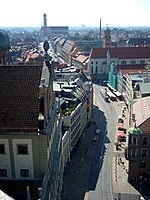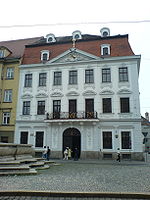Fuggerei

The Fuggerei is the world's oldest public housing complex still in use. It is a walled enclave within the city of Augsburg, Bavaria. It takes its name from the Fugger family and was founded in 1516 by Jakob Fugger the Younger (known as "Jakob Fugger the Rich") as a place where the needy citizens of Augsburg could be housed. By 1523, 52 houses had been built, and in the coming years the area expanded with various streets, small squares and a church. The gates were locked at night, so the Fuggerei was, in its own right, very similar to a small independent medieval town. It is still inhabited today, affording it the status of being the oldest public housing project in the world.
Excerpt from the Wikipedia article Fuggerei (License: CC BY-SA 3.0, Authors, Images).Fuggerei
Meister-Veits-Gäßchen, Augsburg Innenstadt
Geographical coordinates (GPS) Address Website External links Nearby Places Show on map
Geographical coordinates (GPS)
| Latitude | Longitude |
|---|---|
| N 48.368888888889 ° | E 10.904166666667 ° |
Address
Fuggerei
Meister-Veits-Gäßchen
86152 Augsburg, Innenstadt
Bavaria, Germany
Open on Google Maps








